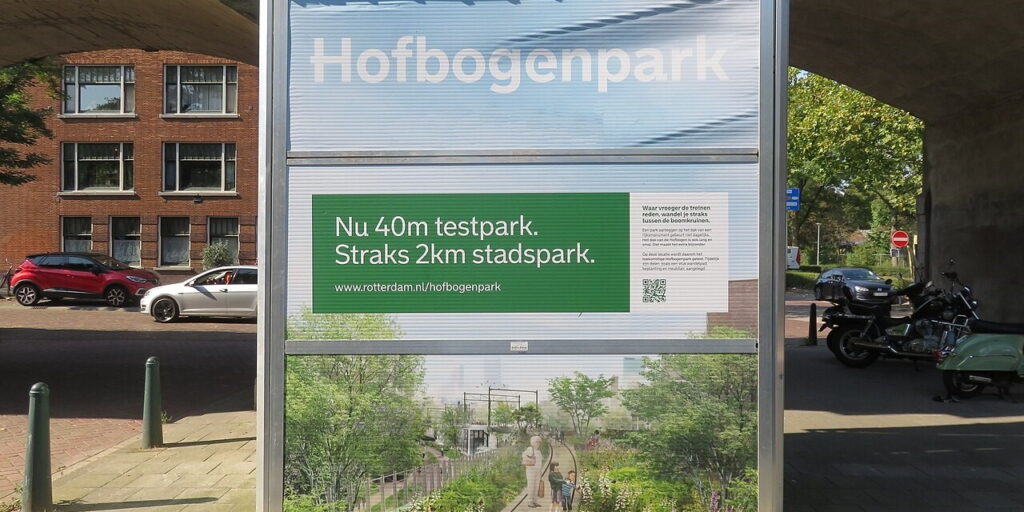The conference event Urban Futures 24, held in the architecturally modernistic city of Rotterdam, brought together academics, mayors and city planning representatives from Europe and beyond, as well sustainable building companies and other stakeholders. The sessions were creative and dynamic, with speaking considering the needs and interests of the different types of participants and involving then actively in the lively discussions. The Urban future community in these annual events deals with innovative approaches to modern city challenges and focuses on the particular features of the host city each time it is held. (Urban Future 2024.) The author attended as part of the activities of the PilotGreen project in which LAB University of Applied Sciences is a partner, with the objective of getting inspiration of this kind of green infrastructural development that this project involves.
Rotterdam as a venue
As a major port city located in a country with large areas below sea level that have been reclaimed that has had to deal with challenges of water inundation for centuries, the challenges of future sea-level rises due to climate change are particularly relevant (Loeper & Ott 2017; Mathos Silva & Costa 2018).
At a session entitled Making climate adaptation in cities really work two very interesting and topical cases from Rotterdam itself were presented. The Water square Benthemplein (Image 1) is a public square with greenery sunken below street level, that most of the time is available in dry form as a free space for different citizen activities. It was described as a vibrant public space, however, approximately 10% of the time, after periods or incidences of heavy rain, it is allowed to fill up with run-off water and it becomes in effect a stormwater detention pond. We were told by the presenter that the feature is so highly held among the population that water from it has even been symbolically used in baptisms of newborn babies. The feature was designed by the company De Urbanisten and officially opened in 2013 (De Urbanisten 2024).

A second impressive development feature presented was the Hofbogenpark Rotterdam (Image 2), which is a presently disused raised section of railway tract 2 km in length that is soon to be repurposed. When completed it will be comparable to the existing High Line in New York City, a 2.3 kilometers long elevated park constructed along a disused railway line. While the first feature described above, the Water Square, is already in place, this development is still underway at the time of writing and is planned to be completed in 2025. The design company De Urbanisten is also involved in this development. In an innovative new scheme these two green infrastructural features will be linked: when completed, the idea is that water gathered from the Water Square will be pumped up to irrigate the vegetation on the Hofbogenpark, eliminating the need for any potable water from the city water supply to be used on this.

The Urban Future community
Apart from just this event in Rotterdam there is a wider Urban Future community. As well as organising annual events, earlier participants are kept informed about issues relevant to the theme of sustainable cities. Citychangers are highlighted by the community and there is special attention given to the next generation of these, with a Young Leaders programme for under 30s forming part of the annual conferences. This writer left Rotterdam with a sense of optimism from the contagious enthusiasm with which such creative and innovative solutions for cities of the future were presented, as well as feeling that what the PilotGreen project is setting out to achieve represents a worthwhile contribution to the kind of urban future envisages at the event.
Author
Paul Carroll is a senior lecturer of environmental technology and urban sustainability at LAB University of Applied Sciences. He acts as a technology expert in the PilotGreen project.
References
Cathrotterdam. 2017. Benthemplein terrain skate gestion eau. Wikimedia Commons. Cited 20 Dec 2024. Available at https://commons.wikimedia.org/wiki/File:Benthemplein_terrain_skate_gestion_eau.jpg
De Urbanisten. 2024. Watersquare Benthemplein. Cited 2 Sep 2024. Available at https://www.urbanisten.nl/work/benthemplein
Douwe Dekker, M. 2024 Hofbogenpark, Rotterdam 40m testpark infobord. Wikimedia Commons. Cited 20 Dec 2024. Available at https://commons.wikimedia.org/wiki/File:2024_Hofbogenpark,_Rotterdam_40m_testpark_infobord.jpg
Loeper, N. & Ott, M. 2017. Water City Rotterdam 2035. WIT Transactions on The Built Environment. Vol. 170, 55–62. Cited 2 Sept 2024. Available at https://www.witpress.com/elibrary/wit-transactions-on-the-built-environment/170/35995
Matos Silva, M. & Costa, J. 2018. Urban Floods and Climate Change Adaptation: The Potential of Public Space Design When Accommodating Natural Processes. Water. Vol. 10 (2). Cited 2 Sep 2024. Available at https://doi.org/10.3390/w10020180
Urban Future. 2024. Cited 6 Jun 2024. Available at https://urban-future.org/




